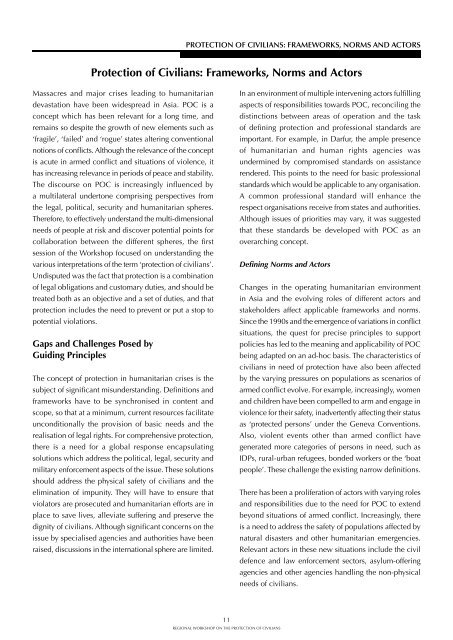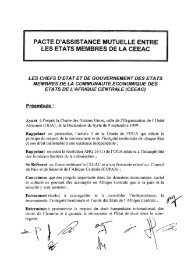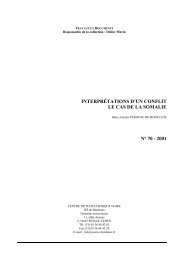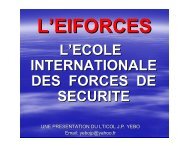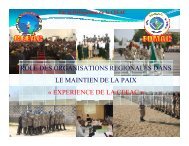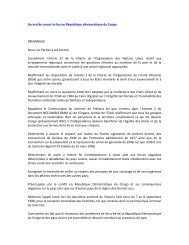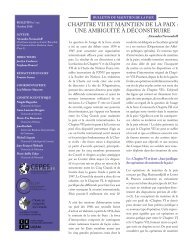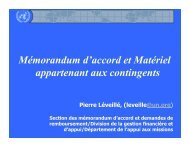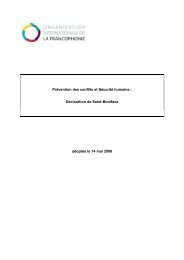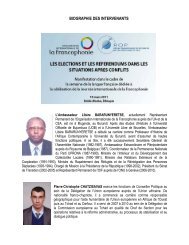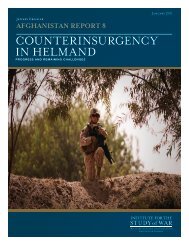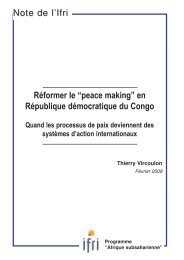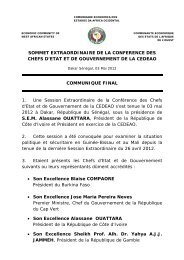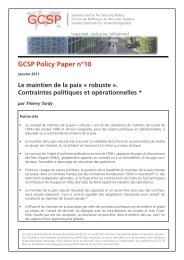Regional Workshop on the Protection of Civilians - S. Rajaratnam ...
Regional Workshop on the Protection of Civilians - S. Rajaratnam ...
Regional Workshop on the Protection of Civilians - S. Rajaratnam ...
Create successful ePaper yourself
Turn your PDF publications into a flip-book with our unique Google optimized e-Paper software.
PROTECTION OF CIVILIANS: FRAMEWORKS, NORMS AND ACTORS<br />
Protecti<strong>on</strong> <strong>of</strong> <strong>Civilians</strong>: Frameworks, Norms and Actors<br />
Massacres and major crises leading to humanitarian<br />
devastati<strong>on</strong> have been widespread in Asia. POC is a<br />
c<strong>on</strong>cept which has been relevant for a l<strong>on</strong>g time, and<br />
remains so despite <strong>the</strong> growth <strong>of</strong> new elements such as<br />
‘fragile’, ‘failed’ and ‘rogue’ states altering c<strong>on</strong>venti<strong>on</strong>al<br />
noti<strong>on</strong>s <strong>of</strong> c<strong>on</strong>flicts. Although <strong>the</strong> relevance <strong>of</strong> <strong>the</strong> c<strong>on</strong>cept<br />
is acute in armed c<strong>on</strong>flict and situati<strong>on</strong>s <strong>of</strong> violence, it<br />
has increasing relevance in periods <strong>of</strong> peace and stability.<br />
The discourse <strong>on</strong> POC is increasingly influenced by<br />
a multilateral undert<strong>on</strong>e comprising perspectives from<br />
<strong>the</strong> legal, political, security and humanitarian spheres.<br />
Therefore, to effectively understand <strong>the</strong> multi-dimensi<strong>on</strong>al<br />
needs <strong>of</strong> people at risk and discover potential points for<br />
collaborati<strong>on</strong> between <strong>the</strong> different spheres, <strong>the</strong> first<br />
sessi<strong>on</strong> <strong>of</strong> <strong>the</strong> <str<strong>on</strong>g>Workshop</str<strong>on</strong>g> focused <strong>on</strong> understanding <strong>the</strong><br />
various interpretati<strong>on</strong>s <strong>of</strong> <strong>the</strong> term ‘protecti<strong>on</strong> <strong>of</strong> civilians’.<br />
Undisputed was <strong>the</strong> fact that protecti<strong>on</strong> is a combinati<strong>on</strong><br />
<strong>of</strong> legal obligati<strong>on</strong>s and customary duties, and should be<br />
treated both as an objective and a set <strong>of</strong> duties, and that<br />
protecti<strong>on</strong> includes <strong>the</strong> need to prevent or put a stop to<br />
potential violati<strong>on</strong>s.<br />
Gaps and Challenges Posed by<br />
Guiding Principles<br />
The c<strong>on</strong>cept <strong>of</strong> protecti<strong>on</strong> in humanitarian crises is <strong>the</strong><br />
subject <strong>of</strong> significant misunderstanding. Definiti<strong>on</strong>s and<br />
frameworks have to be synchr<strong>on</strong>ised in c<strong>on</strong>tent and<br />
scope, so that at a minimum, current resources facilitate<br />
unc<strong>on</strong>diti<strong>on</strong>ally <strong>the</strong> provisi<strong>on</strong> <strong>of</strong> basic needs and <strong>the</strong><br />
realisati<strong>on</strong> <strong>of</strong> legal rights. For comprehensive protecti<strong>on</strong>,<br />
<strong>the</strong>re is a need for a global resp<strong>on</strong>se encapsulating<br />
soluti<strong>on</strong>s which address <strong>the</strong> political, legal, security and<br />
military enforcement aspects <strong>of</strong> <strong>the</strong> issue. These soluti<strong>on</strong>s<br />
should address <strong>the</strong> physical safety <strong>of</strong> civilians and <strong>the</strong><br />
eliminati<strong>on</strong> <strong>of</strong> impunity. They will have to ensure that<br />
violators are prosecuted and humanitarian efforts are in<br />
place to save lives, alleviate suffering and preserve <strong>the</strong><br />
dignity <strong>of</strong> civilians. Although significant c<strong>on</strong>cerns <strong>on</strong> <strong>the</strong><br />
issue by specialised agencies and authorities have been<br />
raised, discussi<strong>on</strong>s in <strong>the</strong> internati<strong>on</strong>al sphere are limited.<br />
In an envir<strong>on</strong>ment <strong>of</strong> multiple intervening actors fulfilling<br />
aspects <strong>of</strong> resp<strong>on</strong>sibilities towards POC, rec<strong>on</strong>ciling <strong>the</strong><br />
distincti<strong>on</strong>s between areas <strong>of</strong> operati<strong>on</strong> and <strong>the</strong> task<br />
<strong>of</strong> defining protecti<strong>on</strong> and pr<strong>of</strong>essi<strong>on</strong>al standards are<br />
important. For example, in Darfur, <strong>the</strong> ample presence<br />
<strong>of</strong> humanitarian and human rights agencies was<br />
undermined by compromised standards <strong>on</strong> assistance<br />
rendered. This points to <strong>the</strong> need for basic pr<strong>of</strong>essi<strong>on</strong>al<br />
standards which would be applicable to any organisati<strong>on</strong>.<br />
A comm<strong>on</strong> pr<strong>of</strong>essi<strong>on</strong>al standard will enhance <strong>the</strong><br />
respect organisati<strong>on</strong>s receive from states and authorities.<br />
Although issues <strong>of</strong> priorities may vary, it was suggested<br />
that <strong>the</strong>se standards be developed with POC as an<br />
overarching c<strong>on</strong>cept.<br />
Defining Norms and Actors<br />
Changes in <strong>the</strong> operating humanitarian envir<strong>on</strong>ment<br />
in Asia and <strong>the</strong> evolving roles <strong>of</strong> different actors and<br />
stakeholders affect applicable frameworks and norms.<br />
Since <strong>the</strong> 1990s and <strong>the</strong> emergence <strong>of</strong> variati<strong>on</strong>s in c<strong>on</strong>flict<br />
situati<strong>on</strong>s, <strong>the</strong> quest for precise principles to support<br />
policies has led to <strong>the</strong> meaning and applicability <strong>of</strong> POC<br />
being adapted <strong>on</strong> an ad-hoc basis. The characteristics <strong>of</strong><br />
civilians in need <strong>of</strong> protecti<strong>on</strong> have also been affected<br />
by <strong>the</strong> varying pressures <strong>on</strong> populati<strong>on</strong>s as scenarios <strong>of</strong><br />
armed c<strong>on</strong>flict evolve. For example, increasingly, women<br />
and children have been compelled to arm and engage in<br />
violence for <strong>the</strong>ir safety, inadvertently affecting <strong>the</strong>ir status<br />
as ‘protected pers<strong>on</strong>s’ under <strong>the</strong> Geneva C<strong>on</strong>venti<strong>on</strong>s.<br />
Also, violent events o<strong>the</strong>r than armed c<strong>on</strong>flict have<br />
generated more categories <strong>of</strong> pers<strong>on</strong>s in need, such as<br />
IDPs, rural-urban refugees, b<strong>on</strong>ded workers or <strong>the</strong> ‘boat<br />
people’. These challenge <strong>the</strong> existing narrow definiti<strong>on</strong>s.<br />
There has been a proliferati<strong>on</strong> <strong>of</strong> actors with varying roles<br />
and resp<strong>on</strong>sibilities due to <strong>the</strong> need for POC to extend<br />
bey<strong>on</strong>d situati<strong>on</strong>s <strong>of</strong> armed c<strong>on</strong>flict. Increasingly, <strong>the</strong>re<br />
is a need to address <strong>the</strong> safety <strong>of</strong> populati<strong>on</strong>s affected by<br />
natural disasters and o<strong>the</strong>r humanitarian emergencies.<br />
Relevant actors in <strong>the</strong>se new situati<strong>on</strong>s include <strong>the</strong> civil<br />
defence and law enforcement sectors, asylum-<strong>of</strong>fering<br />
agencies and o<strong>the</strong>r agencies handling <strong>the</strong> n<strong>on</strong>-physical<br />
needs <strong>of</strong> civilians.<br />
11<br />
REGIONAL WORKSHOP ON THE PROTECTION OF CIVILIANS


